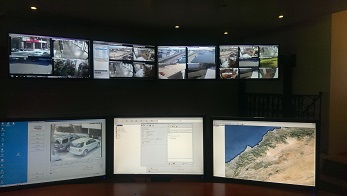- All that video surveillance is commonly expected to do is to transmit live images to help assess the situation “on the ground”, to document incidents and, by means of recorded video sequences, to help clarify what happened after the event. However, the real maxim should be to guard against property and capital crimes and therefore prevent material damage and personal injury. Provided suitably capable technology is used, this approach does not need to remain theoretical but can be offered as a service by security companies. However, before a customer will invest in video technology in addition to conventional alarm systems, he must first be convinced of the benefits.
- Video intervention is a key argument in favor of the use of video technology. Unlike standard intervention by security staff, who must first physically reach the location in question, video intervention measures can be initiated immediately. With the aid of high-quality live images and audio transfer to the building, the operator in the central monitoring station (CMS) can speak to potential intruders directly and repel them – the mere announcement of intervention measures can prevent damage incidents.
- As the central organ for prevention and intervention measures, the CMS plays the most important role. It therefore makes sense for the CMS to sell the concept of video intervention to its customers and to promote it actively as a tailored service package.
The right service package
- The basic, video-based services which an CMS can offer its customers can be grouped into four categories: Monitoring and alarm verification, Video intervention, System diagnosis and Service and automation. Arguments can be presented for every one of these services not just on the basis of greater security” but “lower costs” too .Image-aided video surveillance and video alarm verification by the CMS are therefore indispensable tools in the intervention process, saving both time and money. If an alarm is triggered, the CMS carries out a preliminary alarm test first, in order to rule out the possibility of a false alarm. A video system at the location which is linked intelligently with an Intruder Detection System (IDS) will detect an alarm or hazard situation immediately and automatically provide the alarm receiving centre with the alarm-triggering image.
- To assess an alarm situation, in addition to the alarm image the operator should also be able to view an alarm video sequence comprising both the alarm image and an adjustable pre- and post-alarm sequence. Alarms can be verified, false alarms ruled out and there is no need for cost-intensive investigations at the location itself.
- The transmission of high-quality image data at megapixel resolution, bidirectional audio transmission, PTZ control and receipt of this audio/video data in the CMS are the basic technical requirements for video intervention. If these conditions are in place, the operator in the CMS can take immediate preventive or, in the event of an alarm, protective measures for the active avoidance of damage to property or personal injury. Measures range from timer-controlled, virtual building patrols, personalized guard services and remote control (e.g. of lights, gates and doors) to the checking and repulsion of suspicious persons by means of bi-directional audio transmission. Should conventional, physical intervention still be required at the location, the operator can provide major assistance to the on-site intervention forces using the live images transferred from the building.
- Video systems should be equipped with comprehensive test and diagnostic functions in order to detect and resolve failures as quickly as possible. Heitel Digital Video’s HTconnect procedure does not, for example, just ensure straightforward, secure transfer of audio/video data between IP networks. In addition, it checks that the entire system is functioning correctly – from the camera’s IP transmission path via a video gateway as central system to the control station – and it runs these checks continuously, automatically and in the background. In the case of sabotage attempts (e.g. if cameras are obscured or moved out of position), power failures, system errors or hardware defects, a message is immediately sent to the control station.CMS’ range of video services are rounded off by service functions ranging from armed/disarmed surveillance of the entire IDS, automated, virtual security guard rounds to the creation and export of invoicing data and event protocols.
Conclusion: identify and exploit potential
- Video technology can do so much more than merely document crime. An intelligent video system – monitored by a qualified operator – means considerably higher security and protection of investments. The potential of video intervention and diverse, video-based services is obvious. However, the onus is on security companies to communicate to customers the additional benefits and cost-saving potential of video technology.


